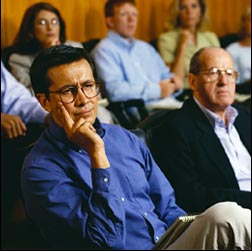The World of Academia

"Academia" refers to the world of higher learning—in other words, the world of educational institutions such as colleges, universities, and research centers.
In academia, the adversarial method is widely accepted as the best way to arrive at the truth about any question. That is why scholars spend so much time debating. It is important to note, however, that these debates don't always taken place in person. In fact, most academic debates take place through the publishing of written papers, and debates can sometimes last for hundreds of years.
In academia, the adversarial method is widely accepted as the best way to arrive at the truth about any question. That is why scholars spend so much time debating. It is important to note, however, that these debates don't always taken place in person. In fact, most academic debates take place through the publishing of written papers, and debates can sometimes last for hundreds of years.
The Adversarial Method in Science
Scientists try to answer questions about the universe and the natural world. For example, an astronomer might try to answer this question:
- Does the sun revolve around the earth, or does the earth revolve around the sun?

So . . . who is right? And how are we supposed to know?
Through the adversarial method, of course!
For hundreds of years, astronomers continued to debate this question—not in person, but by publishing papers that supported one side or the other.
In the end, Copernicus' theory won the debate, because the best evidence was on his side.
Through the adversarial method, of course!
For hundreds of years, astronomers continued to debate this question—not in person, but by publishing papers that supported one side or the other.
In the end, Copernicus' theory won the debate, because the best evidence was on his side.
The Adversarial Method in Social Studies

In Social Studies, we study the way that groups of people behave. For example, a typical question that a historian might try to answer is this one:
Through the adversarial method, of course!
- Why have Israelis and Palestinians been fighting an off-and-on war for more than 70 years?
Through the adversarial method, of course!

So who are we supposed to believe? Who is right?
What is the real reason that Israelis and Palestinians have been fighting a war for more than 70 years?
What is the real reason that Israelis and Palestinians have been fighting a war for more than 70 years?

It's up to the jury to decide—and in this case, we are the jury. It is up to us to read many academic papers—including those of Finklestein and Dershowitz—and then to judge for ourselves which side has presented the best evidence.
That's how the adversarial method works.
That's how the adversarial method works.
The Adversarial Method in English Literature
|
In William Shakespeare's famous play Romeo and Juliet, Shakespeare compares young love to a rose. But what exactly was Shakespeare trying to tell us?
Now don't you want to major in English Literature? |
The Adversarial Method in Engineering

What is the best way to cool a nuclear reactor?
Through the adversarial method, of course! Let's allow people with competing opinions to present their evidence in written papers. Then we can decide for ourselves.
- Should ordinary water be pushed past the nuclear core?
- Or is deuterium oxide a more effective coolant?
Through the adversarial method, of course! Let's allow people with competing opinions to present their evidence in written papers. Then we can decide for ourselves.
Instructions for the Quiz
Answer the Questions.






